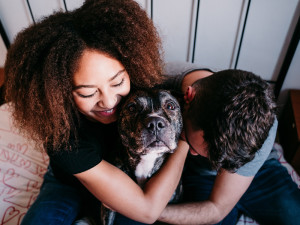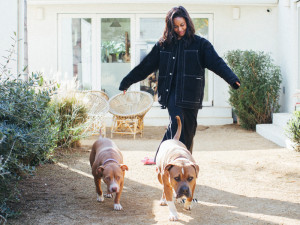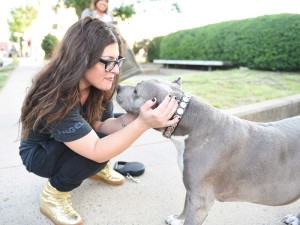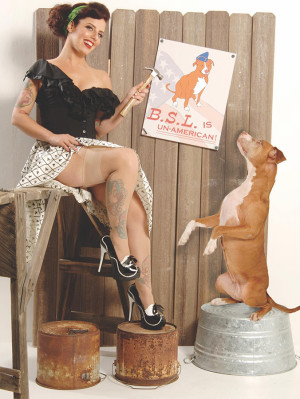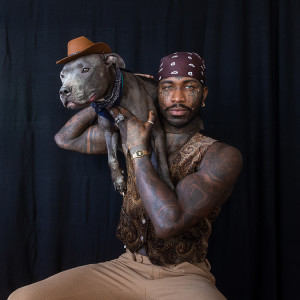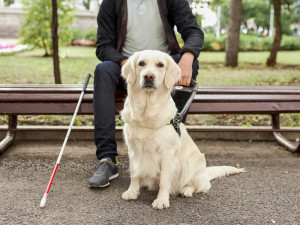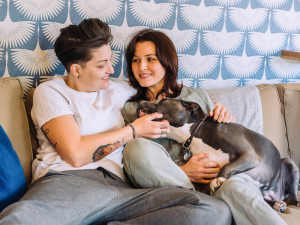Pirate the Pit Bull Is Asha Leo’s “Person”
How the Pit Bull advocate is bolstered by her Instagram-famous psychiatric support dog.
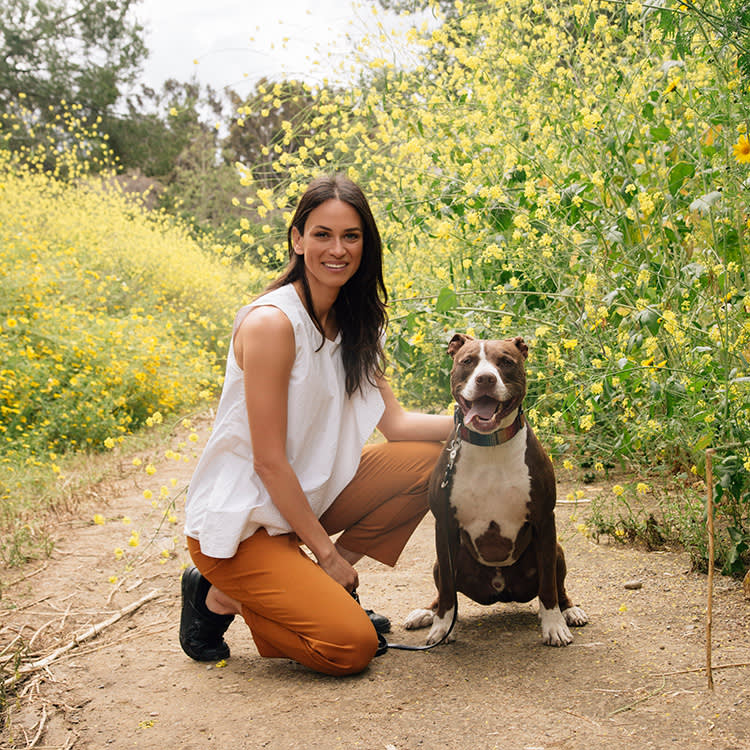
share article
When Asha Leoopens in a new tab brings her rescue Pit Bull, Pirateopens in a new tab, to dog agility competitions, she often gets the same reaction.
“We turn up, and it’s like being in high school again,” Leo tells The Wildest. “People whisper behind our backs, and take a wide berth of us. It’s a horrible feeling, but I know that I don’t have to do anything — Pirate’s just going to show people what he can do.” Pirate, a highly decorated agility champion (who speaks in a British accent, according to his mom), will go out on the agility course and run it flawlessly. He wins, beating out “third-generation champion lineage, $4,000 pedigree dogs,” Leo says. And subsequently, on day two of the trials, Pirate’s reception shifts.
“When we walk in, people will line the course and cheer his name, and I see people nudge each other and go, ‘you need to watch this dog run; he’s really good.’ And when we come out, people want to pet him, want to congratulate him.” But as impressive as Pirate is on the agility course, that’s not what he’s best known for. Hundreds of thousands of fans know him from his Instagramopens in a new tab and TikTok opens in a new tabaccounts where Leo posts about their life together.
Born and raised in London, Leo moved to the U.S. about 14 years ago. She works in the entertainment industry, but her passion is advocating for and dispelling harmful myths about Pit Bulls — including Pirate, who acts as her psychiatric service dogopens in a new tab (PSD). While the world looks at Pirate and sees a Pit Bull first, Leo sees her whole world. As a survivor of childhood sexual abuse who lives with post-traumatic stress disorder (PTSD), Leo depends on Pirate to help her navigate life.
“Pit Bulls are America’s most-feared dogopens in a new tab, and yet he is my lifeline,” Leo says. “I can’t function without him.” She tells The Wildest about why Pirate is her number-one sidekick, her hero, and her family — and why she wants other people to see Pit Bulls the same way.
Let’s start at the beginning: How did Pirate come into your life?
Pirate was a happy accident in my life. I had just moved to a new neighborhood, and I’m a big believer in community. There were all these signs up for a local neighborhood block party. When I got there, it was an adoption event disguised as a block party. I love animals, but I’ve never had a dog before in my life. It sounds so trite, but I saw Pirate, then seven months old and called Sam, in his crate, and I was like, “I need to go see that dog.” There was just something.
By the time I made a beeline over to him, the rescue worker had already seen me coming, slipped a leash on him, and by the time I got there he was handing me his leash saying, “Hey, he’s been in his crate for hours. Do you mind just walking him around the fair?” And I said, “Yeah, I can do that; I’m a good person, I can walk this dog.” Twelve minutes later, I’m in love with him. It’s odd, right? It’s kind of like dating; there’s no reason why you like one person over the other. It’s just chemistryopens in a new tab.
I’m also a very responsible human being, so I took the rescue’s information and walked back to my car. It was a Saturday, so I thought, OK, I’m going to think about it over the weekend and if on Monday morning I still want him, I’ll go back and get him. I sat in my car and thought, But if you decide that you want him and call on Monday morning, and he’s not there, how will you feel? And I got out of my car and walked straight back and got him. Nearly five years later, we’re inseparable.
Pirate’s followers know he’s very well-trained. How did you approach training him?
Bully breedsopens in a new tab and Pit Bull-type dogs are under much higher scrutiny than any other breed of dog. A Goldendoodle can lunge and bark as you walk past, and people think, whatever, maybe it’s scared. But, if a Pit Bull does that, it’s misread as an insight into how it’s a dangerous monster.
In order to advocate for Pit Bulls, I joined a training group called Los Angeles Responsible Pit Bull Ownersopens in a new tab (LARPBO). They really helped me understand that it’s not about training the dog; it’s about training me. My dog is a reaction to me and my energy. And through them, I discovered this incredible world of American Kennel Club certifications, such as the Canine Good Citizen certificationopens in a new tab. It’s considered the gold standard for behavior for dogs, so training for it means being put under pressure and being able to do a lot of things that other dogs might be fearful of.
We also do dog sports — we do Fast CATopens in a new tab, Barn Huntopens in a new tab, trailing and locating, agilityopens in a new tab, and noseworkopens in a new tab. It’s an amazing way to not only bond with your dog, but to also help train obedience. People might think we’re, like, 15-year-old girls with show ponies and rosettes, but it’s so much more than that; it is a real demonstration of the athleticism, loyalty, intelligence and trainability of Pit Bull-type dogs.
You’re very open about your mental health on your platforms. Can you talk about some of the challenges you live with?
I’m a childhood sexual abuse survivor, diagnosed with post-traumatic stress disorder (PTSD), and I’m still tackling a lot of the repercussions of it. I’m enrolled in this new kind of therapy called EMDRopens in a new tab: eye movement desensitization and reprocessing therapy.
Because my trauma happened at a young age, if you were to sit in those feelings, you wouldn’t be a functioning member of society. So, you learn this coping mechanism of locking it all up as a survival technique, and really squashing those emotions. All of the layers that you build up to protect yourself from the trauma in order to function, you have to unlock them all [through EMDR]. But when you open yourself back up, your amygdala, your nervous system, can’t really tell timelines; it just senses danger. And so even though [the trauma] happened 30-plus years ago, when you access prior pain through therapy, your body is put into that state of fight or flight. Your body thinks it’s in danger, which can lead to panic attacks. Some people can have headaches, nausea, nightmares, and fever.
How does Pirate help you through that?
Through this work, there’s been a lot of stuff coming up for me, and, thankfully, Pirate is my task-trained psychiatric service dog. Part of therapy is learning coping techniques to self-soothe, so as a psychiatric service dog, I’ve trained Pirate to help me achieve that state. So, things like retrieval of medicine, or if I’m in a state of panic, I need deep-pressure therapy, grounding techniques. I was doing a session of EMDR two weeks ago and at the end, it feels like — imagine if you had to jump out of an airplane. It’s the feeling of something scary is about to happen. The only way to calm myself is to get Pirate to lay his entire body weight on top of me. And that weight is grounding, because I really try to tune into the cadence of his breathopens in a new tab, the weight of his body; it puts me back into the room and makes me feel safe. We just laid there for 15 or 20 minutes.
I can’t function without him, particularly at moments when I’m really going through some of this trauma work. He doesn’t know why he’s doing it, but he does it because there’s love between us and, as a breed, Pit Bulls want to please. I’m so grateful for him helping me in that way.
It’s ironic that this dog, who has helped you so much, is so feared and demonized by so many simply because of his breed.
States ban Pit Bulls, countries ban them, landlords ban themopens in a new tab, insurances ban them, and to think that this dog has so much of a capacity to heal and help and love and yet people want to deny him of his life? If he’d been found in a different state he would’ve been euthanized on the spot. It breaks my heart that this happens to Pit Bull-type dogs. Bully breeds are incredibly misunderstood, and they have the capacity for such greatness, and my story is just one example of what they can do. I just wish more people could know that.
You do a lot to dispel harmful myths about Pit Bulls on your and Pirate’s social media channels. Do you think those stereotypes are dissipating at all?
If you look back at the 1980s when Sports Illustratedopens in a new tab said [Pit Bulls were] the most dangerous dog in the world, and everyone thought all they were good for was dog fighting, there is definitely a change, for sure. But I think that there are so many systemic issues in place that would need to change for us to get to a place where Pit Bulls are viewed as regular dogs.
Take bite reports, for example. Because people love to go, “Well, how come I only hear about Pit Bulls biting people?” Bite reports are based on an individual’s perception of what a dog is when they report a bite. People will either say, “A dog bit me” or “A Pit Bull bit me”; they usually don’t identify any other breed of dog. Now what is a Pit Bull opens in a new tab — Pirate is mostly American Pit Bull Terrier, so he can carry the name “Pit Bull,” but “Pit Bull” has become an umbrella term that can include the Staffordshire Bull Terrier, American Staffordshire Terrier,opens in a new tab American Bullyopens in a new tab, and American Pit Bull Terrier. Now, because of this miseducation of what a Pit Bull is, that bite report statistic is inflated, biased, and unreliable.
How do you approach what you post on social media given the many stereotypes about Pit Bulls?
I think that part of the reason people have decided to follow [Pirate’s] and my journey is because of our authenticity; it’s because I’m willing to be vulnerable. I’m willing to share the highs and the lows, and real-time what’s happening in our lives. Whenever I share about some of the adventures we go on, some of the times where I’ve been depressed, or when he’s been injured, or I’ve had triggering therapy sessions, those are when we truly connect with people. I think people can see the love between us. I enjoy doing things with my dog, he’s my best friend, and I think when I post stuff like that, people can really relate to it and engage with it.
Someone said that when they were at cancer therapy with their mother, they used to watch Pirate videos to laugh. Fellow survivors message me to tell me that they’re motivated by how open I’ve been. It’s just about being real, authentic, bringing joy, and being vulnerable.
Between Pirate’s accounts and your accounts on Instagram and TikTok, you have hundreds of thousands of followers — and videos that reach millions of views. What’s that experience like?
It’s a love-hate relationship. Let’s start with the good: I think as humans, we’re meant to have community, so it’s a gift to have a community of like-minded individuals who are either dog lovers, Pit Bull lovers, or people who suffer from PTSD — whether they be war veterans, sexual assault survivors, or those who suffer depression from trauma. Sometimes I’ll have 1,000 nice comments on a post, and I’ll think about what it would be like to walk through a room and have 1,000 people say, “Well done. We love you. We support you.”
And then, on the flip side, when his posts go viral, and they go past our community, there are some really hurtful comments. A lot of what I post on social media is very tongue-in-cheek — it’s supposed to be funny. I’m 41, I’m single, and I lightheartedly make fun of that a lot. One video [about that topic got] over 11 million views, and the comments — I don’t know why someone feels the need to tell me I’m going to die alone, how empty I am, how soulless I am, how I’m going to be crying on my deathbed, how no one is ever going to love me. It’s hard because I am going through therapy, and there are some days when I open my phone, and my entire feed of comments is just people telling me I’m worthless.
I try to focus on the people who follow our journey and love us and know what we’re about — and ultimately the good that we can do with it. I’m not going to stop posting because I can help people, and I can help dogs, and that’s really important to me.
In addition to your work on social media, you volunteer with shelters. What is that like and how has it affected you?
Advocating for Pit Bulls has helped me find purpose, passion, community, and support. I use a visualization technique where I think about me at 41 and Asha as a child, and what I would do to help her. And I see these dogs who are abused, through no fault of their own, and the way I feel about them is that I want to tell them, “You are safe, you are loved. It was not your fault.” I want to build their confidence, and through doing that, I’m being the person I wish I’d had when I was younger. There’s such a synergy about how I feel about what happened to me and how I feel about the many Pit Bull-type dogs who have been abandoned. You feel like you’re healing a small part of yourself every time you go help a shelter dog.
How would you describe Pirate’s impact on your life?
What Pirate has added to my life is he’s taken me from being a “me” to a “we.” I’m alone in the USA, and that means that I am alone for Christmas, I am alone for my birthday and other events, but now, because of Pirate, we get to go do fun things together. His joy brings me joy. The other day walking, he was so excited about where we were that while he was walking he fell over his back legs, he did this roll but kept going — and that joy, that surge of happiness and how goofy and silly he is and how happy he was, was just like, “This is what makes me happy.”
Then, of course, there’s his training on top of that, where he actually does help me as a service dog. I’m so unbelievably grateful for him. Yeah, he’s definitely my person. I guess that’s it really: I think having an animal in your life is a gift, we’re really lucky to have them in our lives.

Julie Zeilinger
Julie Zeilinger is a NYC-based writer and editor whose writing has been published in Marie Claire, Vox, HuffPost, Forbes, and other publications. She is also the author of two books: College 101: A Girl’s Guide to Freshman Yearopens in a new tab (2014) and A Little F’d Up: Why Feminism Is Not a Dirty Wordopens in a new tab (2012). She is the mom to Baloo, a two-year-old Bichpoo and foster mom to dogs via Badass Animal Rescueopens in a new tab.
Related articles
![Couple hugging their Pit Bull]() opens in a new tab
opens in a new tabWhat Is a Pit Bull, Exactly?
Everything you need to know about the five breeds dubbed “Pit Bulls.”
![taylour paige and her dogs]() opens in a new tab
opens in a new tabZola Star Taylour Paige on How Her Dogs Taught Her About Love, Presence, and Patience
“Having dogs, rescue dogs, is not always convenient or comfortable — you have to get used to being uncomfortable. But it’s so worth it. The love is immeasurable.”
![Rebecca Corry with her dog]() opens in a new tab
opens in a new tabComedian Rebecca Corry Stands Up for Pit Bulls
“Comedy and entertainment — that’s my passion. But my purpose in life is saving dogs. And somehow I have managed to combine the two.”
![My Pit Bull is Family]() opens in a new tab
opens in a new tab“My Pit Bull is Family” Fights For the Big Little Guys
The fair-housing org’s journey from bumper stickers to databases.
![Deirdre Franklin dressed as a pinup model holding one of her calendars while sitting on a wooden table next to a Pitbull dog sitting on its hind legs looking up at her]() opens in a new tab
opens in a new tabPinups for Pitbulls Rolls Up the Victory Curls For the Pups Who Need It Most
Back in the day, pinup models donned their victory rolls to boost wartime spirits. Now, they do it to advocate for a much-maligned dog breed. Deirdre Franklin, the founder of Pinups for Pitbulls, explains how a burlesque hobby evolved into a life-saving non-profit.
![Yves, a man with a lot of tattoos and a brown paisley head bandana in tan pants holding his grey Pitbull dog who is wearing a tiny cowboy hat over his shoulder]() opens in a new tab
opens in a new tabThe Misunderstood Pit Bull Is at the Top of Yves’s Advocacy List
The model, activist, and musician on his activism philosophy: “I’ve always been drawn to those who have been left behind, forgotten, misunderstood. I relate to them on a very deep, personal level. No matter how different you are, everyone deserves a chance.”
![Backlit photo of a woman seated on an airplane holding her dog in her lap while they both look out of the open window.]() opens in a new tab
opens in a new tabYou Can’t Fly With Your Your ESA, But Your PSD Is Welcome on a Plane
Find out how here, including what the heck those acronyms mean.
![Unrecognizable man sitting on a park bench with his service dog]() opens in a new tab
opens in a new tab10 Misconceptions About Service Dogs and Their Remarkable Partners
No, you can’t pet them when their human isn’t looking.
![Happy lesbian couple cuddling on the couch with pet dog]() opens in a new tab
opens in a new tabGuess Which Shelter Dogs Make Great Service Dogs
Loyal, devoted, and dutiful, Pit Bulls are proving to be pretty well suited to helping humans in need.
